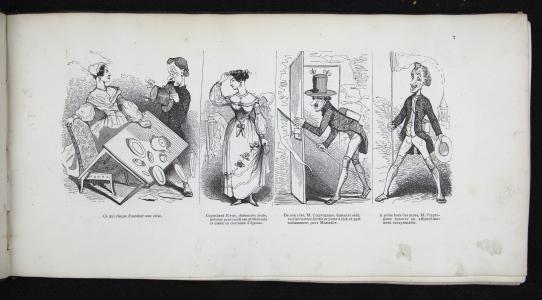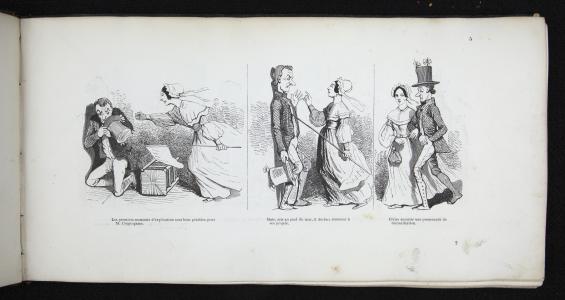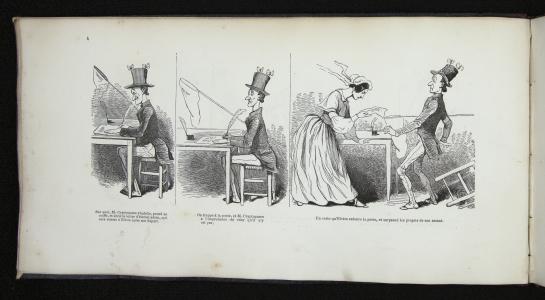

Mr. Cryptogame
1. The complaint, and the consolation; or, Night thoughts
2. The Fables of Æesop, and others / With designs on wood, by Thomas Bewick
5. News from nowhere: or, An epoch of rest, being some chapters from Utopian romance
6. The nature of Gothic, a chapter of the stones of Venice
7. Daphnis and Chloe: a most sweet abd pleasant pastoral romance for young ladies
8. The Sphinx
10. Credo
14. Bible.Old Testament. Song of Solomon.
16. Kem byt’? / V. Mai︠a︡kovskiĭ ; ris. N. Shifrin.
17. The ghost in the underblows
19. Bateau ivre
UCLA Call Number: NC1659 .T647 1846
Mr. Cryptogame
Mr. Cryptogame
Mr. Cryptogame
Mr. Cryptogame
The title page for Mr. Cryptogame is a floral illustration that includes a few of the main characters from the story, including Mr. Cryptogame. The image was created with wood block engravings. The floral design and inclusion of the characters frame the title of the work. Just above the title shows the year in which the work was published, 1846. In the middle of the illustration is stated the publisher, J.J. Dubochet, as well as the location of publication, Paris. This page was included after the original publication of Cryptogame in 1845. The illustrated title page sets the whimsical and comical tone for the rest of the work. The original title page (the second title page) serves more as an introduction to the story of Mr. Cryptogame as well as a reference to other works by Rodolphe Töpffer. The first title page follows the same style as the rest of the story while the second title page is more complex in the detail. Interestingly, the most striking features of the illustrations are the small children that hide behind the rock where the publisher and publishing location are stated. The only children that are shown in the story are the ones that his wife had from a previous marriage. However, the children depicted in the title page do not resemble Mr. Cryptogame’s stepchildren. One can infer that Mr. Cryptogame may have had a few illegitimate children while in Algeria because some of the children are portrayed in a darker skin tone. Someone has written in “par Töpffer” onto the bottom of the title page. It is likely that a cataloger had written this in as the title page does not include the name of the author.
Mr. Cryptogame





Creator: Töpffer, Rodolphe
Publisher: J.J. Dubochet
Publication Place: Paris
Date of Publication: 1846
Dimensions: 17 cm x 32 cm
Physical Description:
The book is oblong and is very lightweight. Morocco leather is used for the binding that covers boards. Both sides of the boards are covered in plain glossy black morocco while the spine is covered in red morocco. There is a small tear on the upper part of the spine that exposes the boards and string. There are no images or text on either side of the cover. The word Cryptogame is written horizontally in majuscules on the spine. Towards the bottom of the spine is printed 1846, the year the work was published. The text and horizontal lines on the spine are embossed in gold. The binding feels warped which may be the result of water damage. The end pages show signs of water damage.
The first title page consists of a large illustration that includes a few characters from the story and outdoor scenery. The title Mr. Cryptogame is centered within the illustration in a large hand drawn whimsical type. The year is also written just above the title. The illustration also includes the publisher and the location in which the book was published. The next page is another large title page illustration that acts as an introduction to the character of Mr. Cryptogame along with a reference to other works by Töpffer. Each page thereafter is comprised of three to four cells of illustrations with Romanized type for the captions of each cell. The language used in the work is French. The illustrations of the work were cut from wood blocks. Black ink is the only color used in the work.
Provenance:
Provenance is unknown. The MARC record states that there is an autograph of “A. Butler” but I did not find that on the object. The first title page has the words “par Töpffer” hand written beneath the title image but it is unlikely the author wrote that in himself.
Condition:
The book shows wear on the binding, particularly on the corners of the cover that exposes the board underneath. There is a tear on the upper part of the spine as well. The majority of the pages throughout the book show a significant amount of foxing and evidence of water damage to the end pages and binding. There are also small wormholes on the last few pages of the book. The majority of the work is in excellent condition given the fact that it is over 150 years old and would have been held mostly by children.
Additional Info:
This is one of the first illustrated story books ever published. Every illustration contains a caption of the events taking place in each cell. The full original title of the work is L’histoire de Mr. Cryptogame. The MARC record states that there is an autograph of “A. Butler” but I did not find that on the object. On the opposite side of the front cover is the words ECL( ? ) ORIGINALE written in blue ink on the top left corner. There is another hand written mark on the first title page with the words par Töpffer below the image, also in blue ink. The handwriting and ink of both marks do appear similar which may suggest that a careless cataloger may be responsible. The ink from the title page mark has bled through the first few end pages. One of the first few pages of the work also includes a whole page dedicated to a small floral design engraving that introduces the printer of the work, Lacrampe et Compagnie. The last few pages towards the back include two illustrations that appear to be advertisements in French. The first advertisement showcases L’illustration, where Mr. Cryptogame was first published. The engraving portrays a bridge in France with the city skyline in the back. Within the image are also boats floating underneath the bridge. The name of the magazine is displayed in a large bold capitalized Roman font on the top with a statement underneath it, in outlined majuscules, that the new editions of the newspaper are available every Saturday. Below the image is a short description of the content in L’illustration along with the prices of different options for a subscription to the newspaper. The second advertisement showcases another publication by Dubochet titled Jerome Paturot: A la Recherche D’une Position Social by Louis Reybaud. The engraving follows the same style of image and type as the previous advertisement with the title of the story in large bold letters in the center with an image engraving relating to the story below the title.
Interpretation:
Rodolphe Töpffer’s Mr.Cryptogame, drawn in 1830, was published in the popular French magazine L’Illustration that spanned several months in 1845. Töpffer’s original hand drawings of Cryptogame were adapted into wood block engravings by Amédée de Noé, also known as Cham, and cut by a team of engravers. The images were reversed in the process and Töpffer’s hand written captions were replaced with simple typography. Mr. Cryptogame was published again in 1846 as one complete work and was one of his last works published before his death.
Mr. Cryptogame, otherwise known as Histoire de Mr. Cryptogame, is one of Rodolphe Töpffer’s first illustrated stories that was part of the new genre he had established over fifteen years earlier. His technique combined the humor of caricature illustration along with the narrative style of story telling. Many argue that Töpffer’s style of visual narrative was the main influence for the comic strip as well as, to some extent, cinematography. The 1846 publication of Cryptogame includes the full story uninterrupted, complimenting the fast paced nature of the story. It was imperative for Töpffer that readers experienced his stories with their imagination simultaneously with all of their senses. Töpffer argued that the illustrations enhanced the reader’s experience by making the story easier to comprehend and enjoy. As a schoolmaster, Töpffer created these picture stories for his own amusement that also served as a way to explore his artistry and writing that would also appeal to the children.
What makes Töpffer’s picture stories like Cryptogame visually interesting are the conscious decisions for the physiognomy of the characters. Töpffer did not resort to using types for facial expressions when trying to convey a character’s mood because types do not consistently reflect nature accurately. Perceptions of emotion may be determined by preconceived biases and misconceptions and can obstruct our understanding of a character’s true nature. Töpffer wanted the characters to tell their story by their countenance and compliment the narration. Töpffer often combined and juxtaposed facial expressions of emotion for each character that effectively created more depth to the character and made the scene of events more interesting.
Cryptogame was first written in 1830, about 15 years before it was first published. During this time, France was experiencing another revolution that would eventually bring an end to the reign of King Charles X. French rulers imposed heavy censorship on the press; caricature drawings were seen as defamatory and were considered attacks on the government subject to the threat of imprisonment and possibly death. It is quite possible that Töpffer had immersed himself in the illustrations of William Hogarth, Honoré Daumier and Gustave Doré and their English caricatures that frequently criticized French rulers.
Cryptogame also offers a glimpse of the feelings Töpffer may have been feeling regarding France’s conflict with Algeria in 1830. Töpffer’s inclusion of Algerian Muslims in Cryptogame as antagonists reveals Töpffer’s awareness of international affairs as well as his political leanings. In the narrative, Mr. Cryptogame encounters Muslims from Algeria who try to murder him and his friends, and the Muslims are portrayed as barbaric, greedy, and dimwitted, and represented in such a manner that mocks Muslim customs and traditions.
Text Content Description:
Mr. Cryptogame is a humorous illustrated story about a young man who loves to collect butterflies, who is unsatisfied with his relationship with his girlfriend, Elvire, and tries to end the relationship with her. Unfortunately for Mr. Cryptogame, Elvire refuses to break up and coerces Mr. Cryptogame to sign a promissory note for marriage. Unable to think of an effective plan to leave Elvire, Mr. Cryptogame gets himself involved in a series of silly and unfortunate events trying to escape her grasp, including being captured and nearly burned alive by Algerian pirates and being swallowed up by a very large whale.
Contributor: Geno Sanchez